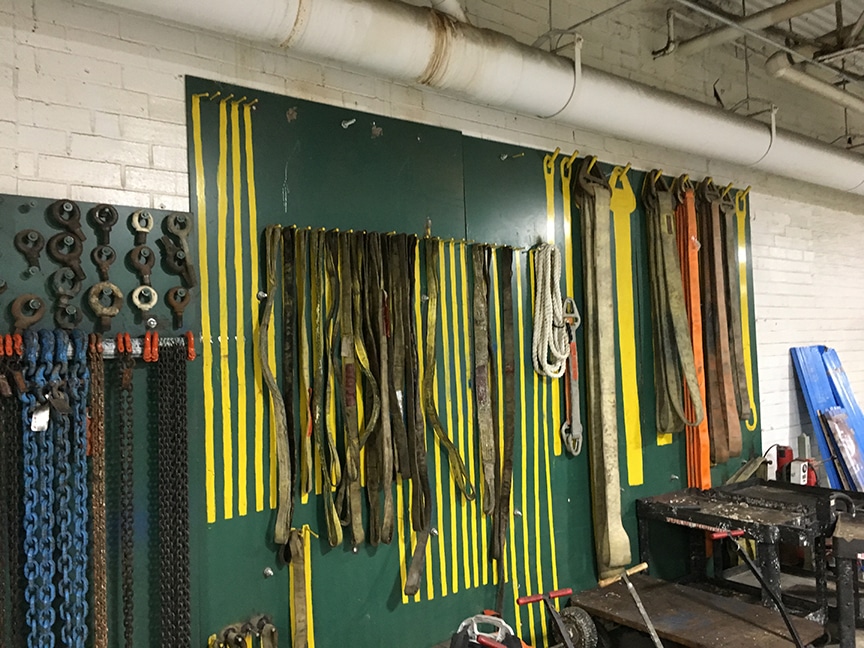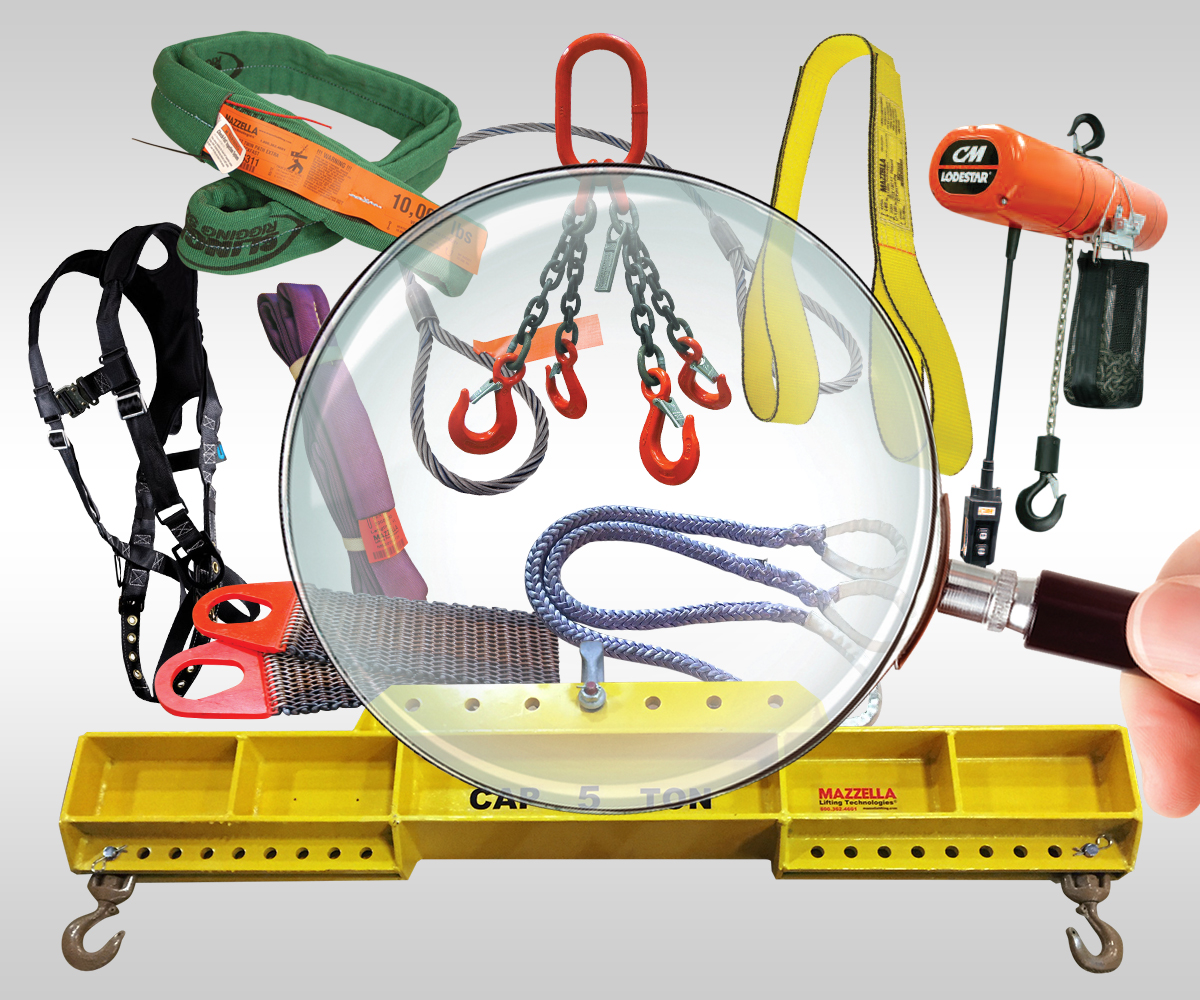How Often Must Slings and Other Rigging Equipment Be Inspected?
You could argue that a sling identification tag is the most important component of a sling assembly. Without it, you don’t have any frame of reference on the rated load and the sling’s capabilities in different hitch configurations and at different sling angles.
As a company who offers third-party rigging inspection services, we often find companies who mistakenly think they’re in compliance when they inspect their rigging gear before each shift and have one documented Periodic inspection performed each year.
The term “annual” often gets used incorrectly when it comes to addressing the frequency of a Periodic rigging inspection. Actually, the term “annual” is never used in either the OSHA or ASME standards when providing a definition for a Periodic inspection, or in the determination of the frequency of a Periodic inspection.
In this article, we’ll help you understand the following:
- How often you need to be inspecting your slings and other rigging equipment
- How often a Periodic inspection needs to be performed
- How to determine Periodic inspection frequencies (and who makes that determination)

How Often Does Rigging Gear Need to Be Inspected?

OSHA and ASME have a variety of standards that relate to the inspection and removal from service criteria for different types of rigging products:
- OSHA 1910.184 – Slings
- ASME B30.9 – Slings
- ASME B30.10 – Hooks
- ASME B30.20 – Below-the-Hook Lifting Devices
- ASME B30.21 – Lever Hoists
- ASME B30.26 – Rigging Hardware
You should familiarize yourself with each standard for specific language and requirements pertaining to each product type. But, all of these products have three different types of inspections that should occur during the service life of the equipment.
Initial Inspection (Prior to Initial Use):
Best practice is to perform a visual inspection of all rigging equipment upon receiving it from the supplier. For hardware, hooks, and slings, double-check the tagging or markings on the products to make sure that it’s what you ordered and that the rated capacity meets all of your project specifications and lifting requirements.
Frequent Inspection (Daily or Prior to Use):
Designate a Competent Person to perform a daily, or pre-shift, hands-on inspection of hardware, slings, and all fastenings and attachments for damage, defects, or deformities. For severe or special service applications, rigging equipment should be inspected before each use. The inspector should also make sure that the rigging gear being used for the lift meets the specific job requirements in which it’s being used for.
Best practice is to perform a visual inspection of your rigging gear before any shift change or changes in lifting application. Users shouldn’t rely on a once-a-day inspection for slings, shackles, hooks, hoist rings, etc. if they’re being used multiple times throughout the course of a day.
Damage to rigging equipment can occur on one lift due to shock loads, severe angles, sharp or rough edges, or exposure to chemicals or heat.
Periodic Inspection (Minimum Every 12 Months):
You should be aware that OSHA and ASME require a documented Periodic inspection of your lifting and rigging equipment every 12 months (at a minimum) and monthly to quarterly inspections in more severe service conditions, based on the following criteria:
- Frequency of use
- Severity of service conditions
- Nature of lifts / load-handling activities
- Experience gained on the service life of equipment used in similar circumstances
ASME provides the following guidelines for Periodic inspection intervals:
- Normal Service – Yearly
- Severe Service – Monthly to Quarterly
- Special Service – As recommended by a Qualified person
Depending on the severity of the operating environment and frequency of use, your business may decide that more thorough / more frequent Periodic inspections should occur.
If your rigging gear is in constant use, or used in a severe service environment, you may not be compliant with only one Periodic inspection each year.
Make sure that a Qualified person has reviewed your lifting and rigging program and can make a recommendation on how often a Periodic inspection should be performed within a 12-month period.
Some Periodic inspections, like the inspection of slings, are required to be documented and you are required to maintain a record of the most recent Periodic inspection. Failure to maintain and retain inspection records is one of the most common issues we see that can prevent a company from reaching full OSHA/ASME compliance.
However, not every type of Periodic inspection requires a documented record of the inspection, so make sure you understand the inspection frequency and records requirements for the lifting and rigging products you use.
Wrapping it Up

Remember, OSHA won’t penalize you for having rigging gear that failed inspection and was removed from service. If anything, you can look at the numbers from your inspection reports and determine if there should be a larger investment in training for your riggers and operators. These types of reports can help you understand:
- Are your employees inspecting their gear before each shift? Inspecting their gear before each lift?
- Do they know how to properly inspect their gear?
- Can they identify damage or irregularities that require the product to be removed from service?
To summarize, the three types of inspections that occur during the service life of a piece of rigging equipment:
Initial Inspection – Make sure you perform an initial visual inspection when you receive any new rigging products from a supplier. Double check the tags on slings, and any and all markings on hardware, to ensure it’s what you ordered and is properly rated for the lift you’re going to perform.
Frequent Inspection – Best practice is to have your riggers and operators perform a hands-on inspection of all rigging equipment prior to any change in shift or change in lifting application. For severe or special service applications, inspect all rigging gear before each use.
Periodic Inspection – Required, at a minimum, once every 12 months. Never use the term “annual” when referring to a Periodic inspection. The severity of service and operating environment may dictate more frequent Periodic inspections (monthly to quarterly) than once every 12 months, as recommended by a Qualified person.
If you’re not confident in your knowledge of the applicable OSHA and ASME standards, or just don’t have the resources to put a lifting and rigging compliance program into place, you should consider a third-party inspection provider.
At Mazzella, we have a dedicated team of Rigging Inspectors that are independently trained and certified. Their only responsibility is to come on-site and perform a thorough inspection of your rigging gear, address solutions as required, and complete the service in a timely manner.
Our inspectors can help you identify compliance issues and identify opportunities for improvement based on their thorough understanding of all applicable OSHA and ASME standards.
If you have questions about rigging inspections, or want to hire a third-party to satisfy OSHA/ASME periodic inspection requirements, please contact us to schedule a consultation. We can partner with you to ensure the peace of mind that safety compliance brings.



Rigging Inspection Services
OSHA 1910.184, ASME B30.9, B30.20, B30.26, & ANSI Z359 require periodic, documented inspections on slings, rigging hardware, lifting devices, and fall protection every 12 months, at minimum, and monthly to quarterly in more severe service conditions.
Call us at 800.362.4601 or click here if you need inspections for slings, rigging hardware, lifting devices, or fall protection!
Copyright 2019. Mazzella Companies.
